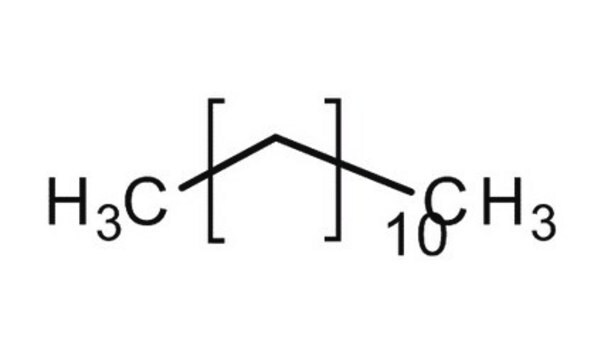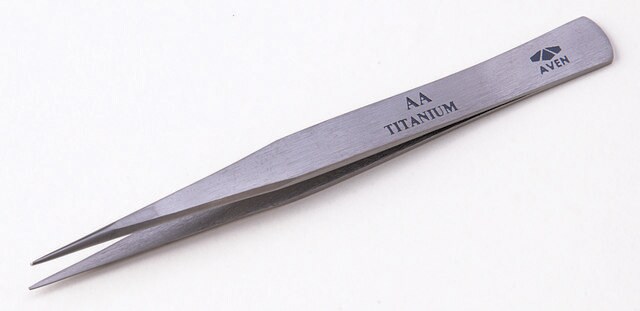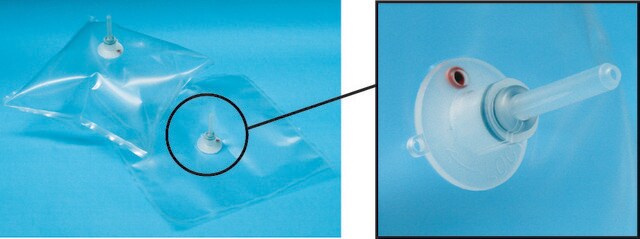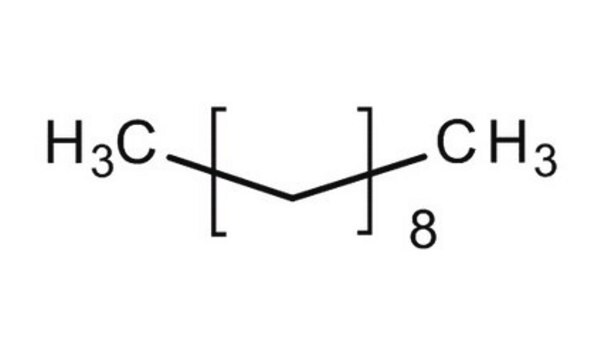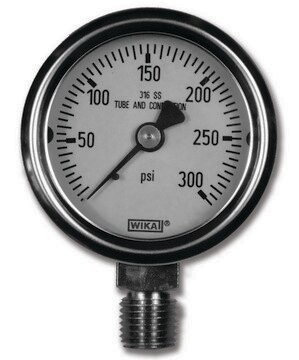All Photos(3)
About This Item
Linear Formula:
CH3(CH2)10CH3
CAS Number:
Molecular Weight:
170.33
Beilstein:
1697175
EC Number:
MDL number:
UNSPSC Code:
12352001
PubChem Substance ID:
NACRES:
NA.21
grade:
reagent
technique(s):
microbiological culture: suitable
bp:
215-217 °C (lit.)
vapor pressure:
1 mmHg ( 47.8 °C)
Recommended Products
grade
reagent
Quality Level
vapor density
5.96 (vs air)
vapor pressure
1 mmHg ( 47.8 °C)
product line
ReagentPlus®
Assay
≥99%
form
liquid
autoignition temp.
401 °F
expl. lim.
8 %
technique(s)
microbiological culture: suitable
refractive index
n20/D 1.421 (lit.)
bp
215-217 °C (lit.)
mp
−9.6 °C (lit.)
density
0.75 g/mL at 25 °C (lit.)
SMILES string
CCCCCCCCCCCC
InChI
1S/C12H26/c1-3-5-7-9-11-12-10-8-6-4-2/h3-12H2,1-2H3
InChI key
SNRUBQQJIBEYMU-UHFFFAOYSA-N
Looking for similar products? Visit Product Comparison Guide
Related Categories
General description
Dodecane is a long-chain linear alkane that is commonly used as a solvent and the major constituent of kerosene. Also, it is employed as an organic phase in solvent extraction.
Application
Dodecane can be used as a solvent in the:
- Extraction of hydrocarbons from Botryococcus braunii.
- Pd/C catalyzed deoxygenation of stearic acid to synthesize biodiesel.
- Oxidativede sulfurization of dibenzothiophenes.
Legal Information
ReagentPlus is a registered trademark of Merck KGaA, Darmstadt, Germany
Signal Word
Danger
Hazard Statements
Precautionary Statements
Hazard Classifications
Asp. Tox. 1
Supplementary Hazards
Storage Class Code
10 - Combustible liquids
WGK
WGK 1
Flash Point(F)
158.0 °F - Pensky-Martens closed cup
Flash Point(C)
70 °C - Pensky-Martens closed cup
Choose from one of the most recent versions:
Already Own This Product?
Find documentation for the products that you have recently purchased in the Document Library.
Customers Also Viewed
Masoumeh Karvar et al.
Langmuir : the ACS journal of surfaces and colloids, 27(17), 10386-10391 (2011-07-07)
Surfactants such as Aerosol OT (AOT) are commonly used to stabilize and electrically charge nonpolar colloids in devices such as electronic ink displays. The electrical behavior of such devices is strongly influenced by the presence of charged inverse micelles, formed
Raquel Silva et al.
Advances in experimental medicine and biology, 733, 155-164 (2011-11-22)
In this work, we report a novel approach using proteinaceous microspheres of bovine serum albumin (BSA), human serum albumin (HSA) and silk fibroin (SF) containing different organic solvents, namely n-dodecane, mineral oil and vegetable oil, to reduce the activity of
Mahnaz Ghambarian et al.
Journal of chromatography. A, 1222, 5-12 (2011-12-27)
The aim of this research was to compare the extraction efficiencies of two modes of three-phase hollow fiber microextraction (HF-LLLME) based on aqueous and organic acceptor phases for analysis of tricyclic antidepressant (TCA) drugs. High-performance liquid chromatography with photodiode array
Dorinde M M Kleinegris et al.
Enzyme and microbial technology, 48(3), 253-259 (2011-11-25)
During the in situ extraction of β-carotene from Dunaliella salina, the causal relationship between carotenoid extraction and cell death indicated that cell growth and cell death should be at equilibrium for a continuous in situ extraction process. In a flat-panel
I Solè et al.
Journal of colloid and interface science, 376(1), 133-139 (2012-04-07)
The influence of different dilution procedures on the properties of oil-in-water (O/W) nano-emulsions obtained by dilution of oil-in-water (O/W) and water-in-oil (W/O) microemulsions has been studied. The system water/SDS/cosurfactant/dodecane with either hexanol or pentanol as cosurfactant was chosen as model
Global Trade Item Number
| SKU | GTIN |
|---|---|
| D221104-2.5L | |
| D221104-2ML | |
| D221104-100ML | 4061837236082 |
| D221104-500ML | 4061837236105 |
Our team of scientists has experience in all areas of research including Life Science, Material Science, Chemical Synthesis, Chromatography, Analytical and many others.
Contact Technical Service